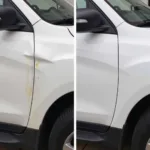Dealing with paint scratches on your car can be frustrating. Whether it’s a minor graze or a deeper gouge, knowing how to repair paint scratches can save you time and money. This guide will walk you through various methods, from simple DIY fixes to more professional approaches, helping you restore your car’s finish. Learn how to assess the damage, choose the right repair method, and achieve professional-looking results.
Fixing minor scratches can often be tackled at home with a car paint repair kit. Let’s delve into the details.
Assessing the Damage: Know Your Scratch
The first step in repairing car paint scratches is determining the severity of the damage. Is it a clear coat scratch, a minor scratch that has penetrated the base coat, or a deep scratch that has reached the primer or metal? This assessment dictates the appropriate repair method. A light scratch might only require a simple polish, while a deeper one might necessitate touch-up paint or even professional intervention.
DIY Solutions for Minor Scratches
For minor scratches that haven’t gone through the color coat, you can often achieve impressive results with DIY methods.
Using a Car Scratch Remover
Scratch removers are formulated to level out minor imperfections in the clear coat. Apply a small amount of the remover onto a clean microfiber cloth and gently rub it onto the scratch using circular motions. This action can often make light scratches disappear completely. Remember to wax the area afterward to restore the protective layer.
Trying a Rubbing Compound
For slightly deeper scratches that have penetrated the color coat, a rubbing compound might be necessary. This is a more abrasive solution than a scratch remover, so use it cautiously. Apply it in the same way as a scratch remover, but be extra careful not to rub too hard, which could damage the surrounding paint.
Repairing Deeper Scratches: More Advanced Techniques
Deeper scratches require more attention and often involve using touch-up paint.
Applying Touch-Up Paint
If the scratch has reached the primer, touch-up paint is often the solution. Start by cleaning the area thoroughly. Then, using a fine-tipped brush or a touch-up pen, carefully apply the paint to the scratch, ensuring it fills the entire damaged area. Allow the paint to dry completely, then lightly sand the area with fine-grit sandpaper to blend it with the surrounding paint. Finally, apply a clear coat and wax for a smooth, even finish.
Considering a Car Paint Repair Bicester Service
For very deep scratches or extensive damage, seeking professional car paint repair bicester is the best option. Experts have the tools and expertise to repair major paint defects, ensuring a flawless result.
Preventing Future Scratches: Proactive Measures
Preventing scratches is always better than repairing them. Regular waxing creates a protective layer that can shield your car’s paint from minor abrasions. Parking carefully and avoiding tight spaces can also minimize the risk of scratches.
Using Car Paint Repair Liquid
For maintaining your car’s paintwork and addressing minor blemishes, consider using car paint repair liquid. These liquids can help fill in minor imperfections and protect the paint.
How to Repair Car Scratch Paint: A Recap
Remember, knowing how to repair car scratch paint depends on understanding the depth of the damage. Minor scratches can often be addressed with DIY methods like scratch removers or rubbing compounds. Deeper scratches require more involved techniques, such as touch-up paint application. And for extensive damage, professional repair is the recommended approach.
For deeper scratches, check out our guide on how to repair a deep paint scratch on a car.
Conclusion
Repairing paint scratches on your car can range from simple DIY fixes to more complex professional repairs. By correctly assessing the damage and choosing the appropriate method, you can restore your car’s finish and maintain its value. Addressing scratches promptly not only enhances your car’s appearance but also prevents further damage, such as rust, from occurring. How do I repair paint scratches on my car? Now you know!
FAQ
-
Can I use toothpaste to remove car scratches? While some claim toothpaste can buff out minor scratches, it’s not a recommended solution. Toothpaste can be abrasive and may damage the clear coat.
-
How much does professional car scratch repair cost? The cost varies depending on the severity and extent of the damage.
-
Can I repair scratches on a leased car myself? Check your lease agreement, as some prohibit DIY repairs.
-
What kind of sandpaper should I use for wet sanding? Use very fine-grit sandpaper, typically 2000-grit or higher, for wet sanding.
-
How often should I wax my car? Waxing every three to four months provides good protection.
-
What if the scratch has gone through to the metal? If the scratch has exposed the metal, it’s best to consult a professional for rust prevention and proper repair.
-
Can clear coat scratches be repaired without repainting? Yes, minor clear coat scratches can often be addressed with scratch removers or polishing compounds.
Common Car Scratch Scenarios
- Key Scratches: These are often deep and require professional attention.
- Parking Lot Scuffs: These can often be buffed out with a scratch remover.
- Tree Branch Scratches: These can vary in depth and may require touch-up paint or professional repair.
Further Resources
For more detailed information on specific car repair topics, check out these articles on our website: “How to Detail Your Car Like a Pro” and “Understanding Car Paint Types.”
Need assistance with car repair? Contact us via WhatsApp: +1(641)206-8880 or Email: [email protected]. Our 24/7 customer service team is here to help.

